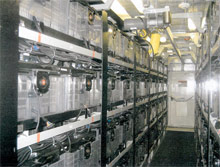Altair Nanotechnologies Inc., a leading manufacturer of safe, high-performance lithium-titanate battery and energy storage products, announced today the successful completion of a demonstration and validation program for a two- megawatt 500 kilowatt-hour battery system purchased by AES Corporation.
The program was developed and validated by KEMA, Inc. and executed by AES personnel and subcontractors. KEMA's testing showed the battery system successfully met the program's milestones, which was conducted to demonstrate the applicability of Altair's large platform technology to frequency regulation, a key service currently provided by power plants to the electric grid. This demonstration also suggests that the technology could be used for several other utility applications.
"The positive AES results validate the immense opportunities in the utility sector," said Terry Copeland, President and CEO for Altair Nanotechnologies. "Our patented lithium titanate battery technology represents a significant advancement in frequency regulation and can provide utilities and generating companies with a valuable tool and resource in the growing challenge of grid management."
"We are pleased with the results of the Altairnano units. This two megawatt validation project is one of the final steps in our move towards commercial deployment of grid-scale energy storage," said Chris Shelton, Director of Energy Storage Development at AES. "Fast-responding, high-efficiency energy storage systems such as these will create a more resilient grid and allow for increased use of variable generating sources such as wind and solar."
The two-megawatt battery system was installed and operated at a substation owned by Indianapolis Power & Light (IPL), an AES company. The system contained two one-megawatt battery storage units each consisting of one Altairnano 250 kilowatt-hour lithium titanate battery stack, AC-to-DC power conversion system, HVAC units, a control system and transformers to connect to the IPL grid. During the validation exercise the capacity of each unit was tested by repeatedly charging and discharging at one megawatt for 15 minutes. In a second test, two megawatts of power from each of the units were used to show the capability of paralleling two separate systems. Additional testing included simulated frequency regulation, which involved switching the units from charge to discharge at up to one megawatt of power every four seconds for several hours. The KEMA summary report will be available on Altair's website, www.altairnano.com and on the KEMA website at www.kema.com.
In August 2007 AES Corporation and Altair Nanotechnologies announced a joint development and equipment purchase agreement. Under the terms of the agreement, the companies will develop a suite of energy storage solutions. This first solution is a modular unit designed to deliver in excess of one megawatt of power and 250 kilowatt-hours of energy per unit. Multiple units can be linked together in systems to provide both more power and more energy storage.
Altair and AES are working together toward utilization of these systems to provide more efficient management of energy quality, frequency control, and real-time energy fluctuations in milliseconds at grid level. The battery systems' extended cycle-life, high-efficiency, and power profile for the continuous delivery of pulses of plus or minus one megawatt to the grid differentiate Altair's battery storage system from other potential solutions in the marketplace.

